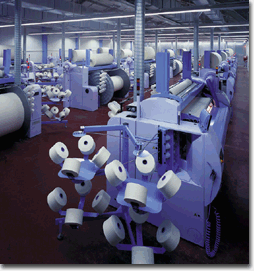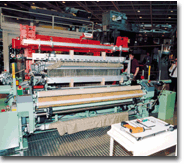I
t seems appropriate before considering the current status of weaving and beyond to
briefly survey some of the history of weaving developments before 2000. When John Kay of Bury,
England, invented his fly shuttle in 1733, he doubled the productivity of hand weaving. He probably
never thought that his shuttle would one day become the bottleneck of weaving.
In the early 1950s, research work was going on in many countries to get rid of the shuttle
and replace it with other means of filling insertion. The goal was to save energy in the insertion
of the pick, reduce noise and vibration and achieve more control in making the loom a true machine.
Some of the results of this work were shown for the first time at the Brussels Exhibition of 1955.
A number of looms using rapiers, others using air-jet, water-jet and tiny grippers were
demonstrated. Another loom of great interest at the time was the circular loom. That was the
beginning of a new era, the era of shuttleless weaving.
Thus the weaving revolution, which started in the second half of the 20th century, continued.
By the 1970s, rapier and projectile looms were widely used, but water-jet and air-jet looms did not
represent a major segment of the U.S. loom market. Water-jet looms were more widely accepted than
air-jet, mainly for filament weaving, because of higher width and speed or higher rate of filling
insertion. However, advances in air-jet looms gave air the edge over water and made air-jet weaving
the most popular in the 1980s and beyond.
Whereas in the early 1950s, developments were mainly directed at filling insertion, in the
1970s, attention was also given to the shedding action. The realization that for high-speed
weaving, the long dwell required for the harness frames in single-phase looms was the limiting
factor for loom speed, led to the development of multi-phase weaving. In single-phase looms, the
functions of shedding, filling insertion and beat-up occur sequentially and for the full width of
the loom. In a multi-phase loom, these three functions occur simultaneously and for more than one
pick. This was first applied in the circular loom and later in a different way for the Saurer 500
rapier loom.
The competition between air-jet and rapier weaving machines continued to intensify during the
last 20 years. We have seen rapier loom speed increase substantially while maintaining a high
degree of versatility. At the same time, air-jet looms continue to increase in speed as well as in
versatility in terms of multi-color and the range of yarns woven.
Currently the two weaving systems, rapier and air-jet, enjoy equally predominant positions in
the weaving industry. This situation may continue until they are challenged by the multi-phase
systems, either the one already developed or what will come in the future. Projectile weaving
machines, which have been challenged during the last two decades, are now finding their niche
applications particularly in the high width range. Widths of up to eight meters are possible for
weaving multiple panels or very wide fabrics for industrial applications. It is an established
fact, that the rate of filling insertion can be increased with width regardless of the weaving
system.

Weaving Automation
 Another
Another
thrust in the development of weaving machinery over the last 30 years has been in the area of
automation. We have seen considerable progress in this area, not only in material handling in the
weave rooms, but also in terms of the operation of the looms themselves. It is anticipated that the
future will show increased intelligence applied to the weaving machines. Although the era of “
weaverless” weaving has not yet arrived, we have seen major strides in this direction.
Many of the operations, which used to be performed by the operator, are now conducted by the
machine. It is expected that this trend will continue. Use of microprocessors and electronic
controls makes it possible to incorporate diagnostic devices to determine the optimum setting for a
specific fabric and to automatically adjust the machine. For example, weaving machines will be
capable of adjusting their speed to avoid machine stops as the quality of the warp and filling
change.
It appears that single-phase weaving has reached the upper limit of speed. The breakthrough is
expected to occur in multi-phase developments. Weft-wave machines, in which small sheds move
independently across the loom with multiple filling carriers going through at the same time, were
shown many times at machinery shows. Because of the poor fabric quality and lack of versatility,
the manufacturers scrapped most of these developments. Nuovo Pignone, Italy, came very close to
commercial state. It is hoped that some company will take this type of development from where
others left them and make the necessary design modification to overcome most of the problems.
Warp-wave looms, in which sheds are opened for the full width of the machine while the
filling is inserted for several picks simultaneously, were attempted by one company in the 1970s.
This was known as the orbit loom, which operated on a curved cylindrical path and suffered from
several limitations. It was shown many times at machinery shows and even had some sales.
This machine was best suited for weaving very loose, open fabrics such as medical gauze. The
recent success to commercial status by Sulzer Ruti, currently Sulzer Textil, of the M8300 weaving
machines is an excellent indication of the potential for this type of weaving. During ITMA ’99, two
machines were shown. The first was weaving print cloth at a rate of filling insertion over 6,000
m/min. The second was weaving a 2/1 twill fabric at a rate of filling insertion in excess of 4,000
m/min. This system is not without limitations, but as is the case with every new weaving machinery
development in the past, persistent improvements are needed to overcome them. Some of the areas
which need attention include weaving of filament yarns, increasing fabric width and weight and use
of multiple colors.
A promising concept that would eliminate many of the problems that faced previous multi-phase
systems, and some of the limitations of the M8300, is the warp-wave air-jet development patented by
McGinley. This system creates sheds, using conventional shedding mechanisms. These sheds are
retained opened by pieces of a tube, which enter into the shed and rotate to become one tube.
Filling insertion takes place by means of air jets as the tube moves forward toward the
fabric. The tube pieces are then rotated in the opposite direction and exit from the shed, leaving
the pick behind to be beaten-up into the fabric.
With several of these tubes moving behind one another in a closed loop, weaving can be
carried out on a flat machine, as shown by the figure. This system has several advantages. One is
the ability to use any shedding mechanism. Another is the reduction in the air velocity required
leading to reductions in the cost of the compressed air, which represents a substantial cost
element in air-jet weaving. Beat-up is performed for the full width of the fabric over a much
smaller distance with the reed having a dwell period against the fell of the fabric.
The ability to weave a wide range of yarns with multiple colors and large widths makes this
system worthy of consideration. The most recent innovation in electronic jacquard head design was
shown by Grosse at ITMA ’99. In this design, the head is driven separately from the weaving
machine, which is a significant development for weaving in general and of major importance for the
McGinley system in particular.
Future Innovations
The next decade is going to be one of multi-phase weaving. All types of weaving machines will
get wider, faster and more intelligent. Because of the expected increase in the use of multi-phase
weaving machines, weave rooms will become quieter. Low noise level is a feature of most multi-phase
systems exhibited in the past. The high width and speed of future weaving machines will have
important implications for yarn preparation and material handling due to the increased size of the
warp beams. The yarn quality and the quality of warping and slashing have to be at the best
possible levels to avoid high levels of machine stops. Proper controls in warping and slashing will
be more critical. Weaving will have to be treated as an integrated manufacturing system more than
ever before.
All the recent and expected developments will help maintain the position of weaving as the
major system for fabric manufacture.
April 2000




